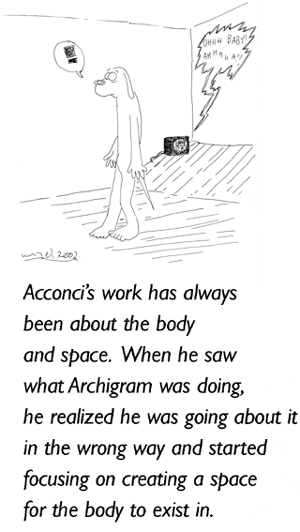
Acconci in need of a Good revisioning
There are cool things about architecture shows, like
the tiny little models. If there has to be an architecture show, Archigram (at
MCA through Jan. 19) is the best bet. It’s a show about the English experimental
architecture group of the ’60s and ’70s that designed all sorts
of space-age stuff, created cool presentations, and underground architecture
zines. What’s most interesting about them is how they took everything
about architecture and turned it upside down. They were all about rock, sci-fi
and comic books. In one of their dynamic films they say, “If cars are
houses that move and airplanes are buses that fly, why not cities that walk?”
So they developed a walking city. It’s very thorough too, the logistics
are all worked out.
Walking through the show, the most apparent thing is how the
Archigram artists seemed to anticipate everything in our culture today. The
colors, designs, aesthetics, the speed. It’s like a world’s fair
for all the things to come that are already here. The future is now, baby.
Vito Acconci was part of a panel discussion about Archigram.
Panelists included the surviving members of Archigram and an architect influenced
by them. I met Vito Acconci before the lecture and said, “Mr. Acconci,
I’d like to shake your hand. It’s great to meet a living historical
art figure.”
To this he replied, “UnhGRRffpfm.”
“I’ll see you downstairs at the lecture,"
I said.
“It should be interesting,” he said as he shuffled
off, like your old relative from Brooklyn.
I told my friend and he said, “Just think, that’s
the hand he jerked off with to make ‘Seedbed.’” He is most
known for “Seedbed,” an inclined platform he built inside a gallery
and then hid under. He had a mic and speaker hooked up and when people came
in, he’d fantasize about them until he came. It doesn’t really have
a clear message or idea. It’s not saying anything, other than, “Oh
baby, I’m jerking off to you in a gallery and I don’t even know
who you are.” So it’s about anonymity, and violation, and the body.
It’s one of those important body-art pieces, so we respect it and say,
so that’s what body art is. He did lots of that kind of stuff, like following
someone around until they went into a private place. Or invading people’s
personal space in a gallery setting. He also did some videos, too. Like “Pry”
where he tried to pry open a women’s eyes while she tried to stop him.
All the work like this, during this time, is fairly illustrative. Like simple
grammar book exercises. I always think of elementary school and filling in words
into sentences when I see conceptual art. It’s all very simple. Follow
someone; follow someone with a camera. Write out definitions. Point out the
obvious. Type things up on a typewriter; take pictures in black in white. Puke.
Sharpen your pencil. Choose the rhubarb. And that’s the milieu of Vito
Acconci. But we are wrong, dead wrong.
He’s an architect now. Where the hell did that come
from? He held up an Archigram book, tattered and worn, and announced, “I
found this in a used bookstore in 1974 and it changed everything.”
Acconci’s work has always been about the body and space.
When he saw what Archigram was doing, he realized he was going about it in the
wrong way and started focusing on creating a space for the body to exist in.
It occurred to him that “Art could only be some kind of folly. Architecture
has to be habitable and functional, even as just an idea. It is inherently fascist
and totalitarian. It changes the way people behave. It should expect that people
will subvert it. It should bulge.”
He was too concentrated on his own person, he wanted to expand.
He looked at self in more general terms, self as part of systems, political,
social, cultural. “Art isn’t something you go into ... My first
art was a resentment of the museum’s ‘don’t touch’ sign.
The art is more expensive than you are. You can’t touch it. It can’t
change. It’s inherent. There’ve been nudges against it.”
So what is he doing now? He makes interactive pieces
like Rube Goldberg devices. You pull a lever, you sit down, pulleys fly and
things change. You sit in a swing and your weight pulls up walls around you
and a house is formed. There is also interaction between people. You can only
enter a solid structure if someone else pedals a bike that opens it up. You
can only exit the structure if someone else lets you out. Acco-nci’s ideas
are extremely complex and intricate. They are also more interesting than the
work itself, but at least he is making things to illustrate his points.